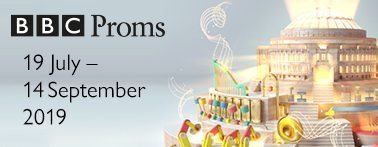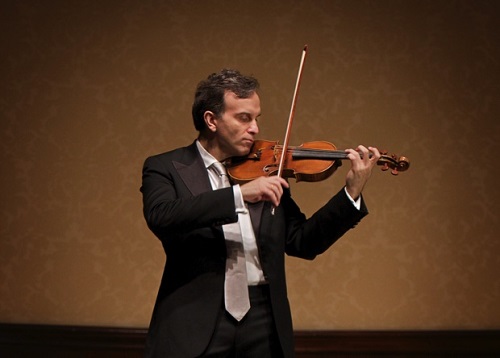
 United Kingdom BBC PROM 17 – Sibelius, Prokofiev & R. Strauss: Gil Shaham (violin), Bavarian Radio Symphony Orchestra / Yannick Nézet‐Séguin (conductor), Royal Albert Hall, London, 31.7.2019. (CS)
United Kingdom BBC PROM 17 – Sibelius, Prokofiev & R. Strauss: Gil Shaham (violin), Bavarian Radio Symphony Orchestra / Yannick Nézet‐Séguin (conductor), Royal Albert Hall, London, 31.7.2019. (CS)

Sibelius – Symphony No.1 in E minor Op.39 (Henry Wood Novelties: UK premiere, 1903)
Prokofiev – Violin Concerto No.2 in G minor Op.63 (Henry Wood Novelties: UK premiere, 1936)
R. Strauss – Der Rosenkavalier, suite
An overture, a concerto and, following an interval, a symphony: such is the tried-and-tested formula. Or, to put it another way: a short orchestral warm-up, an exciting virtuoso sprint, followed by a musical marathon (sometimes almost literally so, for players and audiences), in which a four-movement orchestral work becomes an endeavour which is at once human and spiritual, intellectual and experiential, political and philosophical. Who hasn’t left a concert hall following an epic Romantic struggle for resolution and reason feeling uplifted and exhausted in equal measure?
But, what it one flips the sandwich: symphony, interval, concerto and waltz, anyone? Would one leave the concert hall whirling in a frothy spin rather than floundering in existential eddies? Judging by the smiles on the faces of the punters at the Royal Albert Hall who spilled ebulliently and with a spring in their step on the streets of South Kensington after this concert by the Bavarian Radio Symphony Orchestra, that might indeed be the case. For, the orchestra’s Chief Conductor, Mariss Jansons had dared to invert the ‘natural order’, and to programme a sequence which moved from symphonic deliberations by Sibelius to dancing dalliance by Richard Strauss, with a concerto by Prokofiev serving for the sandwich filling.
Sadly, Jansons had to withdraw from the performance but Yannick Nézet‐Séguin was equally in tune with the cause and with the players of the BRSO, coaxing – quite literally, the baton-less conductor using hands, arms and at times his whole body to embrace and draw forth the strings’ sheen or the woodwinds’ crystalline gestures – a wonderful performance from the orchestra during this, their second, visit to the RAH.
Nézet‐Séguin’s Sibelius felt quite spacious but was fuelled by an unceasing forward movement, quite restless at times, even angry; even the moments of rest and tranquillo stillness were troubled by the slightest tension which quickly accrued mesmeric momentum and power. There was darkness too – as always with Sibelius, a darkness that rises from deep instrumental waters. The first movement’s opening Andante rumbled expectantly as the clarinet roved eerily through the chromatic twists, but the music surely found its direction and it wasn’t long before we were swept up in the restlessness of the plunging, muscular theme as it charged forward. Nézet‐Séguin’s control, and communication, of the movement’s ebbs and flows was superb, and he was aided by some strikingly precise – by turns sensitive and impassioned – timpani playing.
The beauty of the string sound was notable, too, as was the accord of tuning and bow strokes. Their rendition of the first movement’s main melody was imbued with a Romantic lyricism worthy of Tchaikovsky. At the start of the Andante, the muted violins and celli sang a soft lullaby which was simultaneously tender and melancholy, with the clarinet offering a wistful response. The strings’ sigh was never self-indulgent though and, reversed by the woodwind, the theme quickly inspired fresh energy and imitative dialogues which were crisply delineated with clear textures and confident entries. When the lullaby returned at the close, it seemed more weary, resigned; but the Scherzo was a scurrying, agitated affair, initiated by the low strings’ anxious string-brushing and the timpani’s blunt call-to-arms. At times the dance seemed quite wild, all rocking hemiola accents, spitting woodwind and marked pizzicato, though in the central Trio Nézet‐Séguin shaped the modulation to the major tonality with delicious subtlety as the horns temporarily quelled the anxiety.
The Finale followed segue with a heart-rending collective expression of grief, fear and nostalgia from the strings. A shadow seemed to fall over this movement: partly because of the low register of much of the scoring but also because the phrasing seemed imbued with a subtle weight which seemed to me to create a prevailing sense of doubt. The Allegro molto seemed riven by angry protest. Even the violins’ slow theme climbs the fiddles’ lowest string, above off-beat pedals from celli and basses in their deepest realm, and though its climactic restatement was gloriously warm and throbbing with the passion of the supporting pedal, the colour inevitably waned, until the final diminishing timpani trill and quiet pizzicatos drained away into silence.
The sun came out from behind the clouds of pessimism after the interval, in the form of Gil Shaham’s joyful, loving performance of Prokofiev’s Violin Concerto No.2, though the shadows were never entirely banished. The soloist was originally to have been Lisa Batiashvili, who released a recording for Deutsche Grammophon of both of Prokofiev’s Violin Concertos in 2018 with Nézet-Séguin and the Chamber Orchestra of Europe. But Shaham is no stranger to these works and recently followed his 1995 recording with André Previn and the London Symphony Orchestra, with a new recording of the Second Concerto (alongside Bartók’s Second) as part of his 1930s Violin Concertos on the Canary Classics label. Shaham’s performance was characterised by refinement and thoughtfulness, his imaginative reading facilitated by a flawless technique, warm tone, easy projection and detailed engagement with his accompanying partners. From the first gentle steps of the unaccompanied theme to the final furious flourish of the Finale, the silky eloquence and beauty of Shaham’s interpretation were unwavering.
At the start of the Allegro moderato – and with the later recapitulation of the soloist’s opening theme by the unison celli and basses – the spot-on tuning of the BRSO strings made their opening dialogues with the soloist charming and fresh. Nézet-Séguin defined clear textures and the balance between orchestra and soloist was excellent which, even allowing for Prokofiev’s frequently sparse scoring, is no mean feat in this barn of a venue. In fact, often stepping back into the midst of the players, Shaham created a touching intimacy, though he took off with puckish glee in the running passage work, stepping forward again to face the audience, a Pied Piper goading the orchestra to follow him.
The Andante assai was a beautifully simple and lustrous serenade, Shaham relishing Prokofiev’s rhapsodic melodising, his tone suave and plump above the triple arpeggio tip-toeing of pizzicato strings and clarinet. As he launched on his high-wire acts, Shaham created a luscious beam of light against which Nézet-Séguin carefully drew forth the sparkling flute, honeyed clarinet or inky bassoon. The conductor provided the gentlest direction, letting the music unfold like an improvised song as the solo violin soared in flights of reverie, then engaged with dynamism in the more forceful orchestral passages, joining in the dance. There was Prokofiev piquancy and wit – as when the bass drum and bassoon dance their own heavy-footed duet – but anxiety too, as the pace accelerated, and the harmonies pulled in opposing directions. A spiky sharpness characterised the pizzicatos, there was a growling tension in the horns’ chords, though these were ultimately washed away by the cellos’ luscious final statement of the theme, the movement coming tenderly to rest on the double basses’ easeful whisper.
The Allegro ben marcato launched exuberantly, though there was a melancholy latent in the Hebraic-tinged melody and things quickly turned more sombre and then vicious. As the soloist climbed high up the G and D strings, flinging out harmonics to be answered by shrieks from woodwind, the music wound itself up into a grotesque goblin dance, the agitation eventually fragmenting the phrases and rhythmic structure. The coda was a headlong rush off a cliff, as Shaham met the challenge issued by the ominous dry drumbeat of bass drum and double basses. The final cadence may be a flamboyant orchestral flourish, but the spirit was more anarchic than carnival. Shaham, though, retained his beatific smile; clearly he had enjoyed himself as much as we had. His performance had been notable for its care and craftmanship, and the encore – the Gavotte from Bach’s E major Partita – was a fitting complement.
Melancholy and doubt were finally outlawed at the end of the programme, in the Suite, attributed to Artur Rodziński, from Richard Strauss’s Der Rosenkavalier which, as my guest for the evening observed afterwards, is a compilation of all of the opera’s ‘happy bits’! The Bavarians really were in their element here: after all, having conjured Finnish vistas and Russian political landscapes, they now had the chance to play their own ‘native song’. The horns whooped with vulgar glee; the strings swooped, swayed and soared; the woodwind chattered, laughed and made mischief. The reflective passages were tender, the presentation of the rose glowingly warm, blossoming from delicate hope to erotic elation. With cheeky insouciance, Nézet-Séguin almost waltzed himself and his players off the platform. In fact, the entire RAH audience might well have imagined itself in a Bavarian tavern.
In case we were all in danger of overheating with pleasure, Nézet-Séguin cooled things down with a teasingly subtle rendition of Sibelius’s Valse Triste. Bliss.
Claire Seymour
Is that fantastic Prom concert with the Bavarian Radio Symphony Orchestra, Nezet-Seguin conducting (Sibeiius/Prokoviev/Strauss) recorded and available for sale? The most wonderful; Prom ever!
I do hope it is. I had it saved on my TV, but it is now deleted, not by me.
Thanks for any help. And a brilliant review.
Barbara
Very unlikely I would have thought but hope you find a recording somewhere perhaps on YouTube.